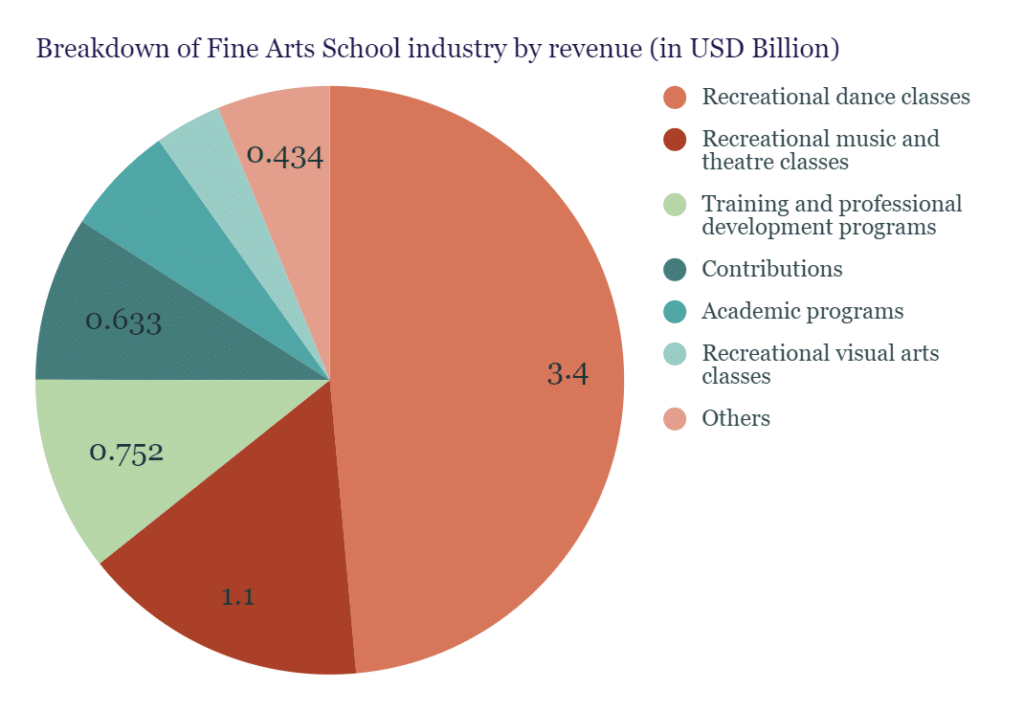Art Schools: Turnover, Startup Costs & Profits (2025)

With a market size of $7.0 billion in 2023 yet over 17,000 art schools vying for a piece of the pie, the art school industry is competitive. What does this mean for art schools’ profits?
How much can an art school expect to earn, and what are the costs involved in setting one up?
In this article, we’ll break down the market segments, average revenues, startup costs, and profitability metrics for the Art schools industry.
Using data from industry sources and insights from over 175 franchised arts schools, we provide a comprehensive financial overview of the Art schools industry in 2025. Dive in to discover the potential of running an Art school and the factors that influence its profitability.
Art Schools Industry Overview
As per IBIS, the Art schools industry in the US represented revenue of $7.0 billion in 2023 and is expected to grow to $7.2 billion over the next five years. Over the next five years, recovering per capita disposable income and recreational spending will drive the industry upwards.
Recreational dance classes represent the largest share ($3.4 billion), followed by Recreational music and theatre classes ($1.1 billion), training and professional development programs ($752 million), contributions ($633 million), academic programs ($424.5 million) and recreational visual art classes ($257.5 million). Yet, with over 16,000 art schools across the country, the competition is also fierce.

What is the average turnover of an Art school Industry?
Using the same source as earlier, it’s safe to assume that the average turnover for the art schools industry is around $412,000. Indeed, the art school industry was worth $7.0 billion in 2023, and there are about 17,000 art schools across the US.
Now, using data from more than 175 franchised art schools, an art school earns $504,000 in gross revenue per year on average.
Many schools receive public funding. Since the art are perceived as essential to the nation’s culture, the industry benefits from reliable charitable donations from individuals and foundations.
Art schools need a large population to serve, the Southeast contains over a quarter of the entire nation’s populace.
Yet, not all art schools have the same yearly revenue. Logically, some will earn more than others because of many factors like time spent on leisure and sports, corporate profit, federal funding for creative arts, demand for donations, grants and endowment, per capita disposable income, number of K-12 students, demand from online tutoring services, etc.
The average annual pay for an art teacher in the United States is $52,000 a year, but the salary range typically falls between $23,000 and $80,000. Salary ranges can vary widely depending on many important factors, including education, certifications, and the number of years you have spent in the profession.
How much does it cost to start an Art school?
On average, it costs between $396,000 and $537,000 to open an art school.
This includes various costs such as site selection and leasehold improvements, furnishings and finishings, equipment, signage, supplies, pre-opening training, advertising, permits & licenses, architectural fees, prepaid insurance premiums, etc.
- Site selection & Leasehold Improvements (64%): construction and/or remodeling costs to build or renovate the facilities, architectural fees, etc.
- Initial Rent Outlays (3%)
- Furniture & Equipment (15%): office equipment, furniture, fixtures, security camera, computer/software.
- Signage (3%)
- Permit & licenses (1.0%)
- Grand Opening Marketing (2%): grand opening marketing expenses as well as local advertising.
- Working capital (3%): funds needed to operate the business to pay for operating costs (such as utility costs & deposits, insurance, opening inventory, pre-opening training, and supplies)
- Additional Funds (9.0%): additional fund for 3-months is required.
How profitable is the Art School industry?
There are various recurring costs involved in running the Art School industry. The major expenses include the Cost of sales and labor costs. Brief details of expenses are as below:
- Cost of Sales (30% – 35%): It includes Teacher wages, merchant processing, tour expenses, music supplies, merchandise costs, and other program expenses. Wages are consistently one of the industry’s top expenses, as having a low instructor-to-student ratio is essential to providing quality training. Total wages are high as fine art schools hire more faculty.
- Management Labor Cost (10% – 15% sales): It includes wages, taxes, benefits, and other employee expenses paid to the general manager employee of the school.
- Admin Labor Costs (3% – 4% sales): It includes wages, taxes, benefits, and other employee expenses paid to the employees of the school.
- Facility lease (10% – 15% sales): includes rent.
- IT expenses (1% sales): Flat fees in all the schools.
- Other expenses (7% – 8% sales): These include utilities, insurance, licenses, permits, repairs, professional fees, and other additional expenses
| Profit and loss | Amount ($) | % of revenue |
|---|---|---|
| Revenue | 504,383 | 100% |
| Cost of sales | (158,376) | 31.40% |
| Gross Profit | 346,007 | 68.60% |
| Management Labor | (73,136) | 14.50% |
| Admin Labor | (17,149) | 3.40% |
| Rent | (71,622) | 14.20% |
| IT Expense | (3,531) | 0.70% |
| Other expense | (37,324) | 7.40% |
| EBITDA | 143,245 | 28.40% |





